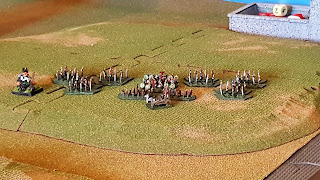 |
| Celtic army and the grating from which it was made. Rifleorc for scale. |
Ever eye that plastic mesh in the craft store? I have. Tried to use it for roads but that wasn't satisfactory. Have used it for sci/fi flooring/grating and that was satisfactory.
Arthur Hannan of EZPainter had an even better idea. Arthur has made 10mm figures out of the stuff. In fact he's published rules to go with them too.
So what we really have in his "Granny Grating Armies" is two-fold, a novel method of making budget armies AND a novel set of ancients rules.
Throughout this post you'll be able to see some figures that Arthur kindly made for me as part of his Kickstarter for this project, but I really think the rules deserve a wider audience.
 |
| A Roman force: legion infantry supported by skirmishers and horse |
So how's it work then?
Each army is composed of a number of units and a leader.
The leader is given a set number of command points per turn.
Pretty standard stuff so far and this is where it gets intriguing.
Units can only take certain number of commands per turn, and these command can be issued on the fly so long as you are done with one unit before shifting to the next.
The enemy can interrupt your turn under certain conditions to issue commands to his troops. Again as troops may only act on a limited number of commands per turn, interrupting the other player now means you will have less flexibility later.
 |
| Celtic force: a small core of foot supported by skirmishers and plenty of horse |
As mentioned before units can only act on a limited number of commands per turn. What I didn't mention before is that units are also limited in how much then can do by their fatigue, here called "energy" level as well.
So an all out attack early can leave you vulnerable to counter attack later if you have neglected to keep a fresh reserve.
Now this idea of tracking fatigue has its roots in some of the earliest post WWII wargames designs, but it is not a feature of many modern games. One reason, and a very good one, is that, at least in the older rules that used the concept, tracking fatigue was a chore.
Not so in GGA! There are only three energy levels; high, medium, and low. So while this does entail some use of markers or rosters the burden is minimal.
The whole stew of commands, units, and energy blends together nicely to give an enjoyable game.
A few other points:
*The game only uses six sided dice.
* In combat each unit just simply rolls their FR, (Front rank number) unless they are below half FR then they roll that number.
* Each troop type is rated for a score need to cause a casualty. It is this number or more that you need to score a hit. Modifiers apply.
* Each troop type is rated for a score need to cause a casualty. It is this number or more that you need to score a hit. Modifiers apply.
*Although designed to be played with multi figure stands, individual casualties are tracked.
This last point makes it very easy to use the game with figures of any scale along with some adjustment of ranges and so forth.
Finally the GGA armies look great. Cute when viewed up close and impressive enough when viewed en masse at table top distance. I may even go this route for my 1812 Russian campaign armies.
GGA is supported by a very friendly Facebook group at:
https://www.facebook.com/groups/GrannyGratingArmies/
If you are on FB come on by and say "Hi".
Arthur is a convivial host and his enthusiasm for this project is quite evident.
If you do give these rules a go, do stop back and let me know how it went for you!
Thanks for stopping by!

No comments:
Post a Comment